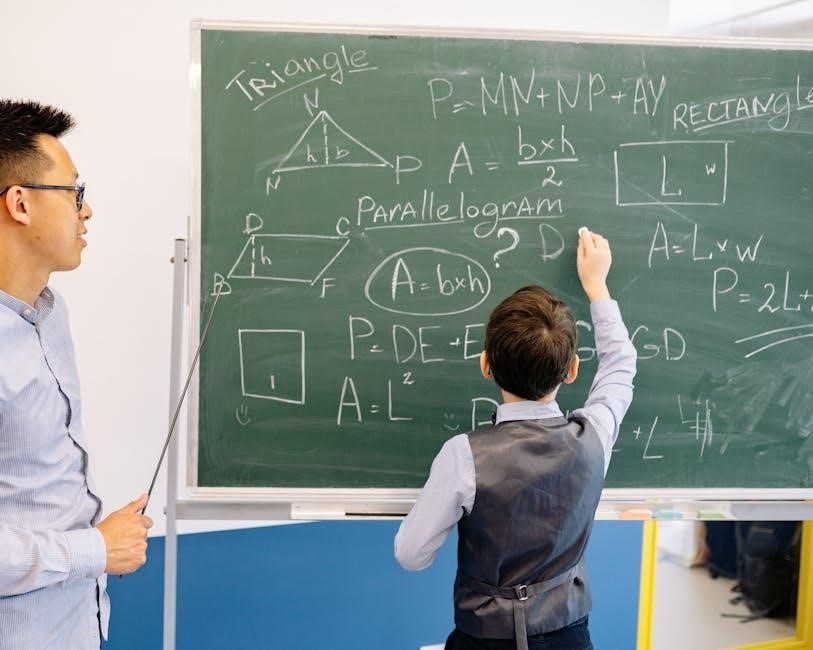Overview of the Instructional Hierarchy
The Instructional Hierarchy is a research-based model outlining the stages of learning: Acquisition, Fluency, Generalization, and Adaptation; It guides educators in structuring instruction to support skill mastery effectively․
1․1 Definition and Purpose
The Instructional Hierarchy (IH) is a research-based, stage-based model of learning that outlines the process of mastering new skills․ It defines learning as progressing through distinct stages: Acquisition, Fluency, Generalization, and Adaptation․ The purpose of the IH is to guide educators in matching instructional strategies to a student’s current learning stage, ensuring effective skill acquisition and mastery․ By conceptualizing learning in this structured way, the IH helps educators make informed decisions to support individual student needs and promote successful outcomes across various curriculum areas․
1․2 Theoretical Background
The Instructional Hierarchy (IH) is rooted in educational psychology and behaviorism, emphasizing the structured progression of skill acquisition․ It draws on theories of learning that highlight the importance of clear instructional sequencing and practice․ The model, developed by Haring, Lovitt, Eaton, and Hansen (1978), is based on the premise that learning occurs in distinct stages, from initial acquisition to advanced application․ This theoretical framework aligns with cognitive and behavioral principles, providing a systematic approach to teaching and ensuring students build a strong foundation before advancing to more complex skills․ This structure supports educators in designing effective, research-backed instruction․

Stages of the Instructional Hierarchy
The Instructional Hierarchy consists of four distinct stages: Acquisition, Fluency, Generalization, and Adaptation․ Each stage builds on the previous one to ensure skill mastery and application․
2․1 Acquisition Stage
The Acquisition Stage is the initial phase where learners are introduced to new skills or knowledge․ During this stage, students often feel confused or frustrated as they encounter unfamiliar content․ The primary goal here is to provide clear instruction and modeling to help students understand the basics․ Educators use techniques like demonstrations and guided practice to ensure learners grasp foundational concepts․ Without a strong foundation in this stage, progress in subsequent stages becomes challenging․ Thus, the Acquisition Stage plays a crucial role in setting the pace for effective learning and skill development․
2․2 Fluency Stage
The Fluency Stage focuses on helping learners perform tasks smoothly, accurately, and with ease․ This stage emphasizes reducing hesitation and error, ensuring skills become automatic․ Educators use timed practice, drills, and repetitive exercises to build speed and consistency․ Positive reinforcement and feedback are crucial to encourage progress․ The goal is to enable students to apply skills effortlessly, preparing them for more complex applications․ Mastery at this stage is essential before moving to the next, as it ensures learners can perform tasks without cognitive strain, fostering confidence and readiness for advanced learning․
2․3 Generalization Stage
The Generalization Stage involves applying learned skills across different settings and situations․ At this stage, learners demonstrate the ability to use acquired skills flexibly and adapt them to various contexts․ Educators encourage this by introducing diverse scenarios, peers, and environments․ The focus shifts from controlled practice to real-world application, ensuring skills are not limited to specific conditions․ Assessments at this stage evaluate how well students can transfer knowledge, highlighting areas where additional support may be needed․ Successful generalization indicates that learners have achieved a higher level of mastery, ready to adapt skills in broader, more dynamic environments․
2․4 Adaptation Stage
The Adaptation Stage focuses on refining and modifying skills to meet new or changing demands․ Learners apply skills in novel contexts, adapting them to solve problems or meet specific requirements․ This stage emphasizes creativity, critical thinking, and the ability to adjust strategies as needed․ Educators encourage learners to explore different approaches and innovate, ensuring skills are not only mastered but also versatile․ The adaptation stage signifies advanced mastery, where learners can independently refine and improve their skills, making them more efficient and effective in diverse situations․ This stage is crucial for long-term retention and practical application of learned abilities․
Instructional Strategies for Each Stage
Effective instructional strategies vary by stage, ensuring tailored support for skill acquisition, fluency, generalization, and adaptation․ These strategies enhance learning outcomes and student engagement significantly․
3․1 Modeling and Guided Practice
Modeling and guided practice are foundational strategies in the Instructional Hierarchy, particularly during the acquisition stage․ Modeling involves demonstrating skills clearly, allowing students to observe and imitate․ Guided practice provides structured opportunities for students to apply new skills with support․ This dual approach ensures students grasp foundational concepts accurately․ By combining observation and hands-on practice, educators help students build confidence and accuracy, reducing confusion and frustration․ These strategies are essential for establishing a strong base for further learning and fluency development․
3․2 Building Fluency Through Practice
Building fluency through practice is a critical step in the Instructional Hierarchy, focusing on helping students perform skills accurately and efficiently․ This stage emphasizes consistent practice, often through drills, timed exercises, and repetitive tasks, to automate learning․ Feedback is essential, as it guides students in refining their performance․ Positive reinforcement and corrective feedback are used to strengthen fluency․ The goal is to ensure students can apply skills smoothly and confidently, reducing hesitation and error․ Fluency building bridges the gap between initial acquisition and broader application, making learning more automatic and efficient for future challenges․
3․3 Promoting Generalization Across Settings
Promoting generalization across settings ensures students apply learned skills in diverse contexts․ This stage involves teaching students to use skills in varied environments, with different materials, and under different conditions․ Educators use strategies like varied practice settings, real-world applications, and collaborative activities to encourage widespread application․ Providing opportunities for students to practice in naturalistic environments helps bridge the gap between controlled learning spaces and real-world scenarios․ This stage focuses on fostering independence and adaptability, ensuring students can apply skills flexibly and confidently across multiple situations, making learning more meaningful and functional in everyday life․
3․4 Encouraging Adaptation and Application
Encouraging adaptation and application is the final stage of the Instructional Hierarchy, where students refine and apply skills in complex, dynamic situations․ Educators promote critical thinking and problem-solving by introducing varied and novel challenges․ This stage emphasizes creativity and adaptability, enabling students to modify skills to fit new contexts․ Real-world projects, open-ended tasks, and peer collaboration are effective strategies to foster deeper understanding and practical application․ The goal is to empower students to independently adapt and apply learned skills in innovative ways, preparing them for lifelong learning and real-world challenges․

Applying the Instructional Hierarchy in Education
Educators use the Instructional Hierarchy to align teaching strategies with student learning stages, ensuring interventions match individual needs for effective skill acquisition and mastery․
4․1 Matching Interventions to Learning Stages
Educators align instructional strategies with each stage of the Instructional Hierarchy to optimize learning․ During Acquisition, explicit teaching and modeling are emphasized․ Fluency building involves practice to enhance accuracy and speed․ Generalization focuses on applying skills across different contexts, ensuring students can use what they’ve learned in varied settings․ Adaptation encourages creative and flexible use of skills, promoting deeper understanding and real-world application․ By tailoring interventions to each stage, educators ensure a progressive and effective approach to skill mastery․
4․2 Assessing Student Progress and Adjusting Instruction
Regular assessment of student progress is crucial within the Instructional Hierarchy․ Educators use formative assessments to monitor mastery at each stage․ During Acquisition, they check for understanding and accuracy․ In Fluency, they measure speed and consistency․ Generalization assessments focus on the ability to apply skills in diverse contexts․ Adaptation is evaluated through creative problem-solving and real-world application․ Based on these assessments, instruction is adjusted to address gaps, accelerate learning, or provide additional challenges․ This data-driven approach ensures personalized support and fosters continuous improvement, aligning instruction with individual student needs and promoting meaningful skill development․

Research and Evidence Supporting the Model
Empirical studies, including Haring et al․ (1978), validate the Instructional Hierarchy’s effectiveness in skill acquisition․ Research demonstrates improved learning outcomes when instruction aligns with each stage․
5․1 Empirical Studies and Outcomes
Empirical studies, such as Haring et al․ (1978), provide strong evidence for the Instructional Hierarchy’s effectiveness․ Research demonstrates that students taught according to the hierarchy show significant improvements in skill acquisition and retention․ The Acquisition, Fluency, Generalization, and Adaptation stages have been consistently validated through experimental designs․ Studies highlight enhanced learning outcomes when instruction aligns with each stage, particularly in reducing errors and increasing accuracy․ These findings underscore the model’s practical application in education, offering educators a reliable framework to optimize teaching strategies and improve student performance across various subjects․ The evidence supports the hierarchy’s role in fostering mastery and long-term retention of skills․
5․2 Practical Implications for Educators
The Instructional Hierarchy offers educators a structured approach to teaching, enabling them to align instructional strategies with students’ learning stages․ By understanding the Acquisition, Fluency, Generalization, and Adaptation stages, teachers can tailor interventions to meet individual needs․ For instance, modeling and guided practice are effective during Acquisition, while practice drills enhance Fluency․ This framework helps educators identify when students are ready to progress, ensuring personalized learning․ It also promotes efficient skill mastery, reducing frustration and increasing academic success․ By applying this model, educators can create targeted, effective instruction that supports diverse learners in achieving long-term mastery of skills․

Importance of the Instructional Hierarchy in Modern Education
The Instructional Hierarchy is crucial in modern education for personalized learning, ensuring students progress through structured stages, achieving mastery and integration of skills effectively․
6․1 Personalized Learning and Skill Mastery
The Instructional Hierarchy supports personalized learning by tailoring instruction to individual student needs․ It ensures learners progress through Acquisition, Fluency, Generalization, and Adaptation at their own pace, fostering mastery․ Educators can align teaching strategies with each stage, addressing gaps and enhancing understanding․ This approach promotes deeper engagement and long-term retention, preparing students to apply skills in diverse contexts․ By focusing on incremental progress, the model ensures no student is left behind, creating a pathway for all learners to achieve proficiency and confidence in their abilities, ultimately fostering independent and skilled learners․
6;2 aligning Instruction with Student Needs
6․2 Aligning Instruction with Student Needs
The Instructional Hierarchy emphasizes aligning instruction with individual student needs by matching teaching strategies to their learning stage․ Educators assess students’ progress and tailor interventions accordingly, ensuring targeted support; This approach fosters personalized learning, enabling students to build skills at their own pace․ By addressing specific needs, educators create a more efficient and effective learning environment, reducing frustration and enhancing outcomes․ This alignment ensures that instruction is relevant and impactful, catering to diverse learner profiles and promoting overall academic success․